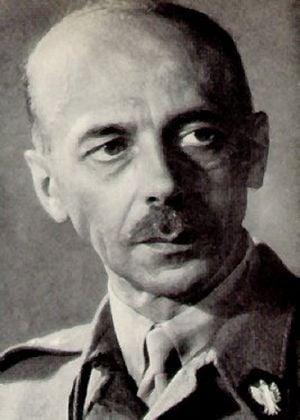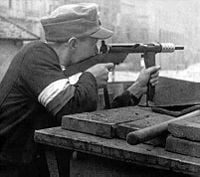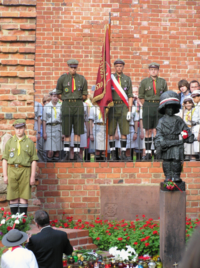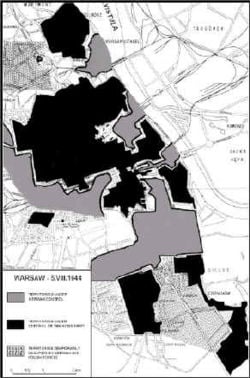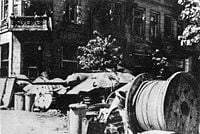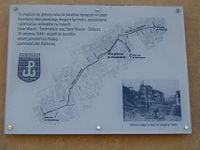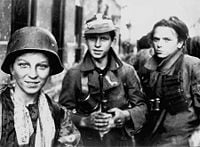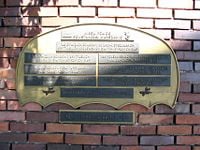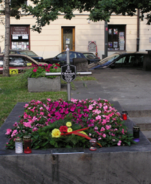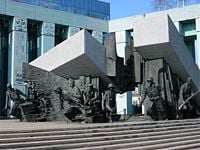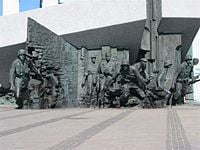| Warsaw Uprising | |||||||
|---|---|---|---|---|---|---|---|
| Part of Operation Tempest, World War II | |||||||
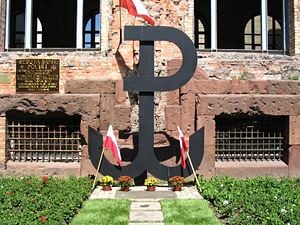 Postwar sculpture, before bullet-pocked Bank of Poland Redoubt, of Kotwica ("Anchor," formed from the letters "P" and "W," for Polska walcz─ůcaÔÇö"Poland Fights"), emblem of the Polish Resistance. | |||||||
| |||||||
| Combatants | |||||||
| Commanders | |||||||
| Tadeusz B├│r-Komorowski┬á#, Antoni Chru┼Ťciel┬á#, Tadeusz Pe┼éczy┼äski |
Erich von dem Bach, Rainer Stahel, Heinz Reinefarth, Bronislav Kaminski | ||||||
| Strength | |||||||
| 50,000 troops (10,000 armed) | 25,000 troops | ||||||
| Casualties | |||||||
| 18,000 killed, 12,000 wounded, 15,000 taken prisoner 250,000 civilians killed |
10,000 killed, 7,000 missing 9,000 wounded | ||||||
The Warsaw Uprising (Powstanie Warszawskie) was an armed struggle during the Second World War by the Polish Home Army (Armia Krajowa) to liberate Warsaw from German occupation and Nazi rule. It started on August 1, 1944, as part of a nationwide uprising, Operation Tempest. The Polish troops resisted the German-led forces until October 2 (63 days in total). Losses on the Polish side amounted to 18,000 soldiers killed, 25,000 wounded, and over 250,000 civilians killed, mostly in mass executions conducted by advancing German troops. Casualties on the German side amounted to over 17,000 soldiers killed and 9,000 wounded. During the urban combatÔÇöand after the end of hostilities, when German forces acting on Hitler's orders burned the city systematically, block after blockÔÇöan estimated 85 percent of the city was destroyed.
The Uprising started at a crucial point in the war, as the Soviet army approached Warsaw. The Soviet army had reached a point within a few hundred meters across the Vistula River from the city on September 16, but failed to make further headway in the course of the Uprising, leading to accusations that Joseph Stalin did not want the Uprising to succeed.
There is no evidence that the Home Army coordinated its struggle with the Soviet army. According to Russian memoirs (for example Konstantin Rokossovsky who led the Warsaw liberation) the Home Army tried to liberate the city before (and without) the Soviet army.
Eve of battle
The Home Army's initial plans for a national uprising, Operation Tempest, which would link up with British forces, changed in 1943 when it became apparent that the Red Army would force the Germans from Poland. The discovery of the Katyn massacre soured Polish-Soviet relations in April, and they never properly recovered. Although doubts existed about the military wisdom of a major uprising, the planning continued nevertheless.
The situation came to a head as Operation Bagration, the Soviet offensive, reached the old Polish border on July 13. At this point the Poles had to make a decision: Either carry out the uprising in the current difficult political situation and risk problems with Soviet support, or fail to carry out an uprising and face Soviet propaganda describing Armia Krajowa as collaborators and ineffective cowards. The urgency of this decision increased as it became clear that after some successful Polish-Soviet cooperation in the liberation of various towns (for example, in the Wilno Uprising), in many cases the Soviet NKVD units who followed behind would either shoot or send to the Gulag most Polish officers and those Polish soldiers who could not or would not join the Soviet Army.
In the early summer of 1944, German planning required Warsaw to serve as the strong point of the area and to be held at all costs. The Germans had fortifications constructed and built up their forces in the area. This process slowed after the failed July 20 Plot to assassinate Adolf Hitler, but by late July of 1944, German forces had almost reached their full strength again. On July 27, the governor of the General Government, Hans Frank, called for 100,000 Polish men between the ages of 17ÔÇô65 to present themselves at several designated meeting places in Warsaw the following day. The plan envisaged the Poles constructing fortifications for the Wehrmacht in and around the city. The Home Army viewed this move as an attempt to neutralize the underground forces, and the underground urged Warsaw inhabitants to ignore it.
More than 1,000 members of German Ordnungspolizei and Sicherheitspolizei have died in the course of their normal police duties; this does not include the losses during participation in any special operations. Alongside those losses, the number of 500 casualties among the various officials of all administration sectors deserves a separate mention (Hans Frank on November 18, 1943).
The official Soviet propaganda tried to portray the Polish underground as "waiting with their arms at ease" and not fighting the common enemy. As the Soviet forces approached Warsaw in June and July 1944, Soviet radio stations demanded a full national uprising in Warsaw to cut German communication lines of units still on the right bank of Vistula. On July 29, 1944, the first Soviet armored units reached the outskirts of Warsaw, but were counterattacked by German 39th Panzer Corps, comprising the 4th Panzer Division, the 5th SS Panzer Division, the 19th Panzer Division, and the Hermann Goering Panzer Division. In the ensuing battle of Radzymin Germans enveloped and annihilated the Soviet 3rd Tank Corps at Wołomin, 15 kilometers outside Warsaw. The Germans crushed its resistance by August 11, inflicting a 90 percent casualty rate on this encircled Soviet force.
On July 25, the Free Polish Cabinet in London approved the planned uprising in Warsaw. Fearing German reprisals following the ignored order to support fortification construction, and believing that time was of the essence, General Tadeusz B├│r-Komorowski ordered full mobilization of Home Army forces in the Warsaw area on August 1, 1944.
This mobilization decision had some key ramifications for relations with the Soviet Union. Joseph Stalin was not officially consulted on the uprising and thus suspected subterfuge from his Western allies. In retrospect, both sides were jockeying for regional political alignment, with the Polish Home Army's desire for a pro-Western Polish government and the Soviet's intention of establishing a Polish Communist regime.
Opposing forces
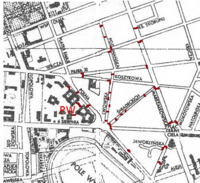
The Home Army forces of the Warsaw District numbered about 50,000 soldiers, 23,000 of them equipped and combat-ready. Most of them had trained for several years in partisan warfare and urban guerrilla warfare, but lacked experience in prolonged daylight fighting. The forces lacked equipment, especially since the Home Army had shuttled weapons and men to the east of Warsaw before making the decision, on July 21, to include Warsaw in Operation Tempest. Besides the Home Army itself, a number of other partisan groups subordinated themselves to Home Army command for the uprising. Finally, many volunteers, including some Jews freed from the concentration camp in the ruins of the Warsaw Ghetto, joined in while fighting continued.
General Antoni Chru┼Ťciel, codename 'Monter', commanded the Polish forces in Warsaw. Initially he divided his forces into eight areas:
- Area I (┼Ür├│dmie┼Ťcie, Old Town)
- Area II (┼╗oliborz, Marymont, Bielany)
- Area III (Wola)
- Area IV (Ochota)
- Area V (Mokot├│w)
- Area VI (Praga)
- Area VII (Powiat Warszawski)
- Zgrupowanie Kedywu Komendy Głównej
On September 20, a reorganization of this structure took place to fit the structure of Polish forces fighting among the Western Allies. The entire force, renamed the Warsaw Home Army Corps (Warszawski Korpus Armii Krajowej) and commanded by General Antoni Chru┼Ťciel (Monter), formed into three infantry divisions.
On August 1, their military material consisted of:
- 1,000 rifles
- 1,700 pistols
- 300 machine pistols
- 60 submachine guns
- 7 machine guns (Meant by medium or light machineguns, such as the MG 42)
- 35 anti-tank guns and carbines (including several PIATs)
- 25,000 hand grenades (Mainly of the "stick" variety).
In the course of the fighting, the Poles obtained further gear through airdrops and by capture from the enemy (including several armored vehicles). Also, the insurgentsÔÇÖ workshops worked busily throughout the uprising, producing 300 automatic pistols, 150 flame-throwers, 40,000 grenades, a number of mortars, and even an armored car.
On August 1, 1944, the German garrison in Warsaw numbered some 10,000 troops under General Rainer Stahel. Together with various units on the left bank of the Vistula River, German forces comprised some 15,000 to 16,000 Wehrmacht soldiers, as well as SS and police forces. These well-equipped German forces had been prepared for the defense of the city's key positions for many months. Several hundred concrete bunkers and barbed wire lines protected the buildings and areas occupied by the Germans. Also, at least 90,000 additional German troops were available from occupation forces in the surrounding area. As of August 23, 1944, the German units directly involved with fighting in Warsaw included:
- Battle Group Rohr (commanded by Major General Rohr)
- Battle Group Reinefarth (commanded by SS-Gruppenf├╝hrer Reinefarth)
- Attack Group Dirlewanger Brigade
- Attack Group Reck (commanded by Major Reck)
- Attack Group Schmidt (commanded by Colonel Schmidt)
- Various support and backup units
- Warsaw Garrison (Group of Warsaw Commandant) commanded by Lieutenant General Stahel
The battle
The uprising began officially in daylight at 5:00 p.m., or "W-hour," August 1, a decision which is now regarded as a costly mistake. Although the Germans failed to realize that extra activity and early fights with the insurgents were linked and had not developed a plan for dealing with the uprising, they received a warning, reportedly from a Polish woman, an hour before the start. Lack of surprise, a sudden change of plan, inexperience in day fighting and incomplete mobilization meant that many of the earlier Polish objectives of the uprising were not achieved. The first two days were crucial in establishing the battlefield for the rest of the uprising. Most successes were achieved in the city center (┼Ür├│dmie┼Ťcie) and old town (Stare Miasto) and nearby parts of Wola, where most objectives were captured, although major German strongholds remained. In other areas, such as Mokot├│w, the attackers almost completely failed to capture their objectives, while in areas such as Wola they captured most of their targets, but with very heavy losses that forced them to retreat. In Praga, on the East bank of the river, the German concentration was so high that the Polish forces fighting there were forced back into hiding. Most crucially, the fighters in different areas failed to link up, either with each other or with areas outside Warsaw, leaving each section of the city isolated from the others.
After the first several hours of fighting, many units adopted a more defensive strategy while the civilian population started erecting barricades throughout the city. The moment of greatest success, on August 4, was also the moment at which the German army began receiving reinforcements. SS General Erich von dem Bach was appointed commander and soon after began to counter-attack with the aim of linking up with the remaining German pockets and then cutting off the Uprising from the Vistula (Wisla) river. August 5 was marked by the liberation of the former Warsaw Ghetto area by insurgents and by the beginning of the Wola Massacre, the mass execution of approximately 40,000 civiliansÔÇöslaughtered by the Germans. A critical aim of this German policy was to crush the will of the Poles to fight and bring the uprising to an end without having to commit to heavy city fighting; until late September, the Germans were, in fact, shooting all captured insurgents on the spot for the same reason. In other areas, the prime aim of the German troops seems to have been to loot and rape rather than fight, which actually allowed the Polish defense to continue against the odds. This German policy was later reversed when the German commanders decided that such atrocities only stiffened the resistance of the Poles to fight their oppressors. From the end of September, some of the captured Polish soldiers were starting to be treated as POWs. On August 7, German forces were strengthened by the arrival of tanks with civilians being used as human shields. After two days of heavy fights they managed to cut Wola in two and reach the Bankowy Square.
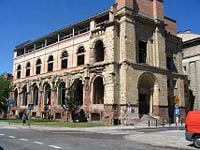
The German aim was to gain a significant victory to show the Home Army the futility of further fighting, forcing them to surrender, but it did not succeed. Between August 9 and August 18, pitched battles raged around the Old Town and nearby Bankowy Square, with successful attacks by the German side and counter-attacks from the Polish side. Once again, German "special" tactics were demonstrated by targeted attacks against clearly marked hospitals (reminiscent of Luftwaffe attacks against hospitals in September, 1939). The Old Town was held until the end of August, when diminished supplies made further defense impossible. On September 2, the defenders of the Old Town withdrew through the sewers, which at this time were becoming a major means of communication between different parts of the uprising. More than 5,300 men and women were evacuated in this way.
German tactics very much hinged on bombardment through the use of huge cannons (including the Schwerer Gustav supergun) and heavy bombers against which the Poles, without any anti-aircraft artillery and few anti-tank weapons, were unable to effectively defend.
The Soviet army captured Eastern Warsaw and arrived on the Eastern bank of the Vistula in mid-September. When they finally reached the right bank of the Vistula on September 10, the officers of the Home Army units stationed there proposed recreating the pre-war 36th "Academic Legion" infantry regiment; however, the NKVD arrested them all and sent them to the Soviet Union.
However, Soviet attacks on the 4th SS Panzer Corps east of Warsaw were renewed on August 26, and they slowly pressed the 4th SS Panzer Corps into Praga, and then across the Vistula. Many of the "Soviets" who arrived in Poland were actually from the 1st Polish Army (1 Armia Wojska Polskiego), and some of them landed in the Czerniak├│w and Powi┼Ťle areas and made contacts with Home Army forces. With inadequate artillery and air support, most were killed and the rest were soon forced to retreat. After repeated, almost unsupported attempts by the 1st Polish Army to link up with the insurgents failed, the Soviets limited their assistance to sporadic and insignificant artillery and air support. Plans for a river crossing were suspended "for at least 4 months," since operations against the 5 panzer divisions on the 9th Army's order of battle were problematic at that point, and the commander of the 1st Polish Army, General Zygmunt Berling, who ordered the crossing of the Vistula by his units, was relieved of his duties by his Soviet superiors. From that point on, the Warsaw Uprising was a one-sided war of attrition, that is, a fight for acceptable terms of surrender. Fighting ended on October 2, when the Polish forces were finally forced to capitulate.
Life behind the front lines
In the first weeks of the Uprising on Polish-controlled territory, people tried to recreate normal life in their free country. Cultural life was vibrant, with theaters, post offices, newspapers, and similar activities. Boys and girls of the Zwi─ůzek Harcerstwa Polskiego, or Polish Scouts, acted as couriers for an underground postal service, risking their lives daily to transmit any information that might help their people. Near the end of the Uprising, lack of food, medicine, overcrowding, and obviously indiscriminate German air and artillery assault on the city made the civilian situation more and more desperate.
Lack of outside support
The limited landings by the 1st Polish army represented the only external troop forces which arrived to support the uprising. More significantly, there were limited airdrops from the Western allies. The Royal Air Force, in which a number of Polish, Australian, Canadian, and South African pilots flew, made 223 sorties, losing 34 aircraft), but the effect of these airdrops was mostly psychological. The Soviets briefly (September 13ÔÇô28) provided some airdrops, but without parachutes and only when the uprising was on the verge of collapse. They actively prevented Allied assistance by denying landing rights to Allied aircraft on Soviet-occupied territory, even shooting down a number of those which carried supplies from Italy.
American support was also limited. After Stalin's objections to supporting the uprising, Churchill telegrammed Roosevelt, on August 25, with a proposal to send planes in defiance of Stalin, to "see what happens." Unable and unwilling to upset Stalin before the Yalta Conference, Roosevelt replied on August 26 with: "I do not consider it advantageous to the long-range general war prospect for me to join you in the proposed message to Uncle Joe."
The American airbase at Poltava in the Ukraine was used for an airdrop during the "Frantic Mission" in mid-September. However, this action infuriated Stalin, who immediately forbade all Allied presence in Soviet airspace.
Capitulation
On October 2, General Tadeusz B├│r-Komorowski signed the capitulation order for the remaining Polish forces (Warszawski Korpus Armii Krajowej or Home Army Warsaw Corps) at the German headquarters in the presence of General von dem Bach. According to the capitulation agreement, the Wehrmacht promised to treat Home Army soldiers in accordance with the Geneva Convention, and to treat the civilian population humanely. Fighting was so fierce that SS chief Heinrich Himmler remarked, "One of the most deadly fights since the beginning of the war, as difficult as the fight for Stalingrad," to other German generals on September 21, 1944.
The next day, the Germans began to disarm the Home Army soldiers. They later sent 15,000 of them to POW camps in various parts of Germany. Between 5,000-6,000 insurgents decided to blend into the civilian population hoping to continue the fight later. The entire Warsaw civilian population was expelled from the city and sent to a transit camp Durchgangslager 121 in Pruszk├│w. Out of 350,000-550,000 civilians who passed through the camp, 90,000 were sent to labor camps in the Reich, 60,000 were shipped to death and concentration camps (Ravensbruck, Auschwitz, and Mauthausen, among others), while the rest were transported to various locations in the General Government and released.
The Warsaw uprising was unsuccessful largely due to the failure of the Soviet Red Army to aid the Resistance. The Red Army was ordered not to link up with or in any way assist the Resistance forces. They took up a position just a short distance away on the right bank of the Vistula. The Soviet military gave a shortage of fuel as the reason why they could not advance, but post-war political considerations were largely responsible for Stalin's action. Had the uprising succeeded, the Polish government-in-exile in London would have increased their political and moral legitimacy to reinstate a government of its own, rather than accept a Soviet regime. By halting the Red Army's advance, Stalin guaranteed the destruction of Polish resistance (which would undoubtedly also have resisted Soviet occupation), ensuring that the Soviets would "liberate" Warsaw, and that Soviet influence would prevail over Poland.
Destruction of the city
After the remaining population had been expelled, the Germans began to destroy the remains of the city. Special groups of German engineers were dispatched throughout the city in order to burn and demolish the remaining buildings. According to German plans, after the war, Warsaw was to be turned into a lake. The demolition squads used flame-throwers and explosives to methodically destroy house after house. They paid special attention to historical monuments, Polish national archives, and places of interest: Nothing was to be left of what used to be the city.
By January 1945, 85 percent of the buildings were destroyed: 25 percent as a result of the Uprising, 35 percent as a result of systematic German actions after the uprising, the rest as a result of the earlier Warsaw Ghetto Uprising (15 percent) and other combat including the September 1939 campaign (10 percent). Material losses were estimated at 10,455 buildings, 923 historical buildings (94 percent), 25 churches, 14 libraries including the National Library, 81 primary schools, 64 high schools, Warsaw University and Warsaw University of Technology, and most of the historical monuments. Almost a million inhabitants lost all of their possessions. The exact amount of losses of private and public property, including pieces of art and monuments of science and culture, is considered enormous. Various estimates place it at an equivalent of approximately 40 billion 1939 U.S. dollars. In 2004, the Warsaw self-government authorities estimated that the approximate loss of the municipal property is 45 billion 2004 U.S. dollars (this includes only the property owned by the city of Warsaw on August 31, 1939, and not the properties owned by the inhabitants themselves). The municipal council of Warsaw is currently disputing whether claims for German reparations should be made. Destruction was so bad that in order to rebuild much of Warsaw, a detailed landscape of the city which had been commissioned by the government before the Partitions of Poland, painted by two Italian artists Bacciarelli and Canaletto who ran an arts school there as well, had to be used as a model to recreate most of the buildings.
The Red Army enters Warsaw
The Red Army finally did cross the Vistula River on January 17, 1945. They captured the ruins of Festung Warschau in a few hours, with little or no opposition from the Germans. German units put up some minor resistance in the Warsaw University area, but Soviet forces broke the German defenses in less than an hour. This advance was facilitated when the German High Command redeployed 4th SS Panzer Corps from the Warsaw area to Budapest in December 1944.
Legacy
Due to a lack of cooperation and often the active, aggressive moves on the part of the Soviets and several other factors, the Warsaw Uprising and Operation Tempest failed in their primary goal: To free part of the Polish territories so that a government loyal to the Polish government-in-exile could be established there instead of a Soviet puppet state. There is no consensus among historians as to whether that was ever possible, or whether those operations had any other lasting effect. Some argue that without Operation Tempest and the Warsaw Uprising, Poland would have ended as a Soviet republic, a fate definitely worse than that of an "independent" puppet state, and thus, the Operation succeeded at least partially in being a political demonstration to the Soviets and Western Allies. Due to the Warsaw Uprising, the Soviets stopped their offensive in Poland to let the Germans suppress the uprising. Some historians speculate that if they had not stopped their march, they would have occupied all of Germany rather than just the eastern section.
Overall, Polish casualties were between 150,000 and 200,000; more importantly, many of those lost were the people who would have played important and even critical roles in the country's recovery (although many of the Polish intelligentsia had already been killed at the time of the Soviet and German invasions in 1939). The city of Warsaw was rebuilt, and the Old Town was restored to its former state. However, complete recovery as a major European capital only began in the early 1990s after the fall of communism.
After the war
Most soldiers of the Home Army (including those who took part in the Warsaw Uprising) were persecuted after the war, either captured by the NKVD or Polish secret police, Urzad Bezpieczenstwa, interrogated and imprisoned, and tried on various charges. Many of them were sent to gulags or executed or simply "disappeared." Most of those sent to POW camps in Germany were later liberated by British, American and Polish forces and remained in the West, including uprising leaders Tadeusz B├│r-Komorowski and Antoni Chru┼Ťciel (in London and the United States, respectively).
In addition, members of the Polish Air Force flying supplies to the Home Army were likewise persecuted after the war and many others "disappeared" after their return to Poland. Once word got back to the Polish flyers still in England, many decided not to return to Poland.
Factual knowledge of the Warsaw Uprising, inconvenient to Stalin, was twisted by propaganda of the People's Republic of Poland, which stressed the failings of the Home Army and the Polish government-in-exile, and forbade all criticism of the Red Army or the political goals of Soviet strategy. Until the late 1960s, the very name of the Home Army was censored, and most films and novels covering the 1944 Uprising were either banned or modified so that the name of the Home Army did not appear. Further, the official propaganda of both communist Poland and the USSR suggested that the Home Army was some sort of a group of right-wing collaborators with Nazi Germany. From 1956 on, the image of the Warsaw Uprising in Polish propaganda was changed a little bit to underline the rank and file soldiers' bravery, while the officers were still villified as treacherous and the commanders were criticized for their disregard as to the losses. The first serious publications on the topic were not issued until the late 1980s. In Warsaw, no monument to the Home Army could be built until 1989. Instead, efforts of the Soviet-backed Armia Ludowa were glorified and exaggerated.
In the West, the soldiers' story faced a different political problem. The Polish fight for Warsaw with little Allied support was an embarrassment. Then came the shock for the Home Army soldiers as Western Allies recognized the Soviet controlled pro-Communist regime installed by Stalin; as a result, the story was not publicized for many years.
The courage of soldiers and civilians involved in the Warsaw Uprising, its betrayal, and the repressiveness of the Soviet client state contributed to keeping anti-Soviet sentiment in Poland at a high level throughout the Cold War. Memories of the Uprising helped to inspire the Polish labor movement Solidarity, which led a peaceful opposition movement against the Communist government during the 1980s, leading to the downfall of that government in 1989, and the emergence of democratic political representation.
After 1989, censorship of the facts of the Uprising ceased, and August 1 has now become a celebrated anniversary. On August 1, 1994, Poland held a ceremony commemorating the 50th anniversary of the Uprising. Germany and Russia were invited to the ceremony, although there was opposition to Russia's invitation. On July 31, 2004, a Warsaw Uprising Museum opened in Warsaw.
Warsaw President Lech Kaczyński, President of Poland , established a historical commission in 2004, to estimate material losses that were inflicted upon the city by German authorities. The commission estimated the losses on at least 45.3 billion euros ($54 billion) in current value.
Several other cities and regions that experienced destruction by Germany have followed Warsaw, including Silesia, Mazowsze and city of Poznań, and said they would prepare their own estimates of war-time material losses.
ReferencesISBN links support NWE through referral fees
- Bartoszewski, W┼éadys┼éaw. Dni walcz─ůcej stolicy. Warsaw: ┼Üwiat Ksi─ů┼╝ki, Muzeum Powstania Warszawskiego, 2004. ISBN 83-7391-679-2.
- B├│r-Komorowski, Tadeusz. Secret Army. New York: Macmillan Company, 1951. ISBN 0-89839-082-6.
- Davies, Norman. Rising '44: The Battle for Warsaw. Viking Books, 2004. ISBN 0-670-03284-0.
- Karski, Jan. Story of a Secret State. Simon Publications, 2001. ISBN 1-931541-39-6.
- Kirchmayer, Jerzy. Powstanie Warszawskie. Warsaw: Ksi─ů┼╝ka i Wiedza, 1978. ISBN 83-05-11080-X.
- Nowak-Jeziorański, Jan. Courier from Warsaw. Wayne State Univ Pr, 1982. ISBN 0-8143-1725-1.
External links
All links retrieved May 3, 2023.
- The Warsaw Uprising daily diary, written in English by Eugenuisz Melech, on the events as they happened. Edited and published by Dr Lester Gideon & Associates.
- Warsaw Uprising Museum in Warsaw
- Warsaw Uprising 1944 A source for checking data used in this page and offers of material and help.
- the Warsaw uprising on the Polish Resistance page provides information and maps which may be freely copied with attribution.
- My Warsaw Madness. The Other Side of the Warsaw Uprising. The testimony of assault engineer Mathias Schenk.
- The Warsaw Rising
- Polish Boy Scouts Deliver "AK" Mail
- Warsaw Life: A detailed account of the 1944 Warsaw Rising, including the facts, the politics and first-hand accounts
- (Polish) Dariusz Baliszewski, Przerwa─ç t─Ö rze┼║! Tygodnik "Wprost," Nr 1132 (08 August 2004)
- (German) Warschau- Der letzte Blick German aerial photos of Warsaw taken during the last days before the Warsaw Uprising
Credits
New World Encyclopedia writers and editors rewrote and completed the Wikipedia article in accordance with New World Encyclopedia standards. This article abides by terms of the Creative Commons CC-by-sa 3.0 License (CC-by-sa), which may be used and disseminated with proper attribution. Credit is due under the terms of this license that can reference both the New World Encyclopedia contributors and the selfless volunteer contributors of the Wikimedia Foundation. To cite this article click here for a list of acceptable citing formats.The history of earlier contributions by wikipedians is accessible to researchers here:
The history of this article since it was imported to New World Encyclopedia:
Note: Some restrictions may apply to use of individual images which are separately licensed.

